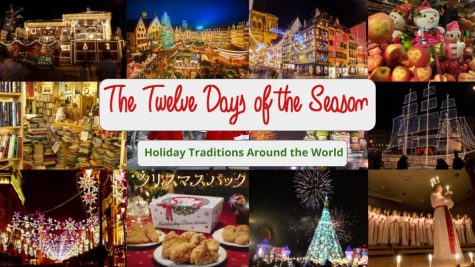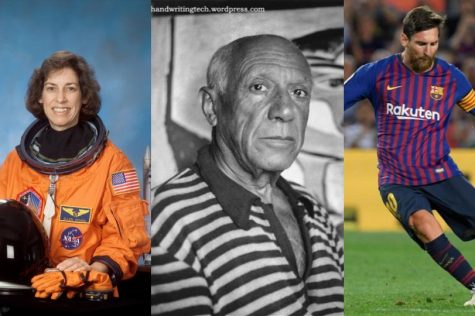The Twelve Days of the Season: How the world celebrates the winter holiday
December includes houses decorated with Christmas lights, shopping deals at every corner, Christmas trees as far as the eye can see.
These classic sights are just what we expect in America. What do other countries experience at the holidays?
Holiday traditions around the world vary from seemingly American-copied Christmas cheer to a unique practice that can’t be found anywhere else. From holiday roller skating to a fried chicken dinner on Christmas Day, people around the world have their own traditions.
Maligayang Pasko!: The festivities never end in the Philippines
In the Philippines, the holiday season starts as early as September. During that time, people shop and decorate in preparation for the winter holiday.
Christmas decorations are popular, with people decorating their homes with poinsettias, Santa Claus statues, and more. A more unique decoration is the Parol, which is a bamboo pole with a star-shaped lantern on it.
In December, the decorations find their purpose as the holiday activities begin. Simbang Gabi is a religious Christmas tradition; people attend mass from three to five in the morning starting on December 16 and ending on Christmas Eve.
The real celebration begins after Christmas Eve. Noche Buena is a midnight feast on Christmas day that’s an open-house celebration with family and friends. People gather around the table to celebrate the holiday and each other.
Common foods eaten on Noche Buena are lechon (roasted pig), ham, fruit salad, rice cakes, and steamed rice.
Frohe Weihnachten!: The German tradition of Advent and more
In Germany, the practice of counting down the days until Christmas is almost as important as the holiday itself. This tradition is called Advent, and although it’s practiced all over the world, it finds its roots in Germany.
Adventskranz is the original tradition of the Advent wreath, which had four candles that were lit on each Sunday before Christmas.The more modern version of this is the Adventskalender, which is a piece of cardboard with 24 windows or flaps that children can open every day before Christmas and receive candy or small toys.
When Advent begins, Christmas markets known as Weihnachtsmärkte are set up in every town. Markets are decorated with lights and Christmas trees, and townspeople are able to gather to listen to music, drink, and purchase holiday goods from vendors.
Each region has a slightly different market. The most famous is Nürnberger’s Christkindlesmarkt, which is known for gold foil angels and gingerbread cakes, It’s at last 375 years old, and is the largest market in Germany with over 200 vendors each year!
Germany has its fair share of decorations as well. Christmas trees, or Tannenbaum, are traditionally put up on Christmas Eve, but some put them up during the Advent season. Christmas lights are another common and festive way to decorate for the season.
Many American Christmas traditions come from Germany. The Western idea of Santa Claus comes from the German Weihnachtsmann, who is a similar looking Christmas figure, though the German version is supposedly a descendant of Saint Nick.
Joyeux Noël!: How French traditions celebrate both the season and their faith
The Christmas season in France begins on December 6 with Saint Nicholas’ Day. This is a religious tradition and not a nationwide holiday, but it’s celebrated all over France with a variety of traditions.
For Saint Nicholas’ Day, children will place their shoes by the fireplace or the door on the night of December 5, and on December 6, “Saint Nicholas” will have filled them with candies, fruits, and nuts. It’s similar to the Western tradition of stockings, but is based on the historical actions of Saint Nicholas of Myra, who was said to put coins in people’s shoes.
When it comes to more festive Christmas traditions, a classic Christmas decoration would be the nativity scene, or la crèche.
Among the typical figures representing the birth of Jesus, la crèche will often display clay figures called santons, or saints. Santons represent everyday people – such as bakers, farmers, hunters, and more – as a part of the nativity scene.
A French tradition celebrated on Christmas day is Les Treize Desserts, or The Thirteen Desserts – a series of desserts eaten after the Christmas feast that symbolize Jesus and the Twelve Apostles. Typical desserts include fruit, nuts, and a cake called Pompe a l’huile.
Sheng Dan Kuai Le!: How China uses the season to celebrate friends and family
In China, Christmas is considered more of a commercial holiday than a religious one, but it’s celebrated nonetheless.
Instead of staying in with family like people do in Western tradition, people in China treat Christmas more like Valentine’s Day. They spend it by going out with friends and family and having a good time!
Common places to go are the movies, ice skating, amusement parks, and of course, shopping malls. Christmas Eve is said to be the biggest shopping day in China, after all.
A unique and popular tradition in China is to give apples on Christmas Eve. These apples are wrapped in colorful paper and might have a holiday design printed onto them. This tradition comes from the fact that in Mandarin, the word for “apple” sounds like “Christmas Eve.”
The Western figure of Santa Claus does appear in Chinese Christmas decorations, but he has a unique twist. The reason is unknown, but in China, Santa Claus is almost always depicted as playing the saxophone!
Gleðileg Jól’!: Iceland’s unique traditions of the season
Like many other countries, Iceland does practice the tradition of Advent. Starting from the fourth Sunday before Christmas, they count down the days until the holiday.
One unique seasonal event in Iceland is the “Christmas Book Flood.” Iceland sells more books than any other nation in the world, and most are sold during the Christmas season.
This is likely because in Iceland, it’s considered a tradition that everyone receives one book to take to bed with them on Christmas Eve, along with some chocolates. Discussion of book sales for Christmas can begin as early as November!
After the season is over, people often discuss the books and authors that they’ve read.
Setting the festivities aside, the Yuletide season in Iceland is considered a way to remember departed loved ones. On Christmas Eve, families will visit the graves of loved ones and place a candle upon them to show that they’re remembered and missed.
Feliz Navidad!: Venezuela puts a unique spin on common seasonal traditions
Christmas is a colorful holiday in Venezuela! Firework shows are a common occurrence to celebrate the oncoming season. Public streets and homes alike will also be lit up with Christmas lights to add to the color and cheer of the holiday.
Traditional Christmas music is Gaita music, which is a type of folk music made from a variety of different instruments. Another popular type of Christmas music is Aguinaldos y Parrandas, which is popular because it sounds like carols.
While some families do decorate with Christmas trees, nativity scenes, or Nacimiento, are much more common.
Both early morning and late night mass are important religious traditions; however, there is a holiday twist. Venezuela has a unique tradition of rollerskating to morning church services from December 16 to December 24. This tradition is so popular that roads are even closed by 8:00 in the morning to make it safe for skaters!
S Rozhdestvom Khristovym!: Russia sheds a new light on old traditions
Christmas in Russia is actually celebrated on January 7. This is because the Russian Orthodox Calendar uses the old ‘Julian’ calendar for religious celebrations, which causes Christmas day to fall later in the year than it does for the rest of the world.
In Russia, presents are actually given during New Year’s, not Christmas. Ded Moroz, or Grandfather Frost, is the Russian equivalent of Santa Claus who gives out presents on New Year’s Day. He is always accompanied by his granddaughter, Snegurochka, or the Snow Maiden.
On New Year’s Eve, children will hold hands around the Christmas tree and call for the arrival of one or both of them. When they arrive, the star and the lights on the Christmas tree will light up!
Following Christmas is Svyatki, or Russian Christmastide. It lasts until January 19, which is the day that Epiphany is celebrated. This two week period is characterized by caroling and fortune telling as celebration for this religious holiday.
Kala Christougenna!: Greece gives Christmas decorations a deeper meaning
Greece shares many Christmas traditions with the West, but they have a more traditional twist. For example, in Greece, Saint Nicholas is said to be the protector of sailors.
Because of this belief, an old Christmas decoration would be a boat decorated with lights instead of a Christmas tree. These days, however, the most common Christmas decoration in Greece is a wooden bowl with a piece of wire around the rim. On the wire is a small wooden cross with basil wrapped around it.
The decorated bowl is supposedly a method of keeping away the Killantzaroi. An old myth states that these goblin-like creatures only appear during the twelve days of Christmas. The wooden bowl is usually filled with water that can be sprinkled around the house to keep these creatures away.
Christmas trees are becoming a more popular, modern tradition, but the bowl is still present.
Another tradition of the season is the Greek form of caroling. On Christmas Eve, children will go out singing kalanda, or carols, in the streets. They may also play small instruments and carry boats decorated with Christmas lights as they sing.
If they’re lucky, children can be rewarded with gifts of food and candy if their singing is good enough.
Feliz Navidad!: Spain’s long and festive season
The Spanish National Lottery becomes a big deal at Christmastime. Almost everyone plays it, making it the biggest lottery draw in the world! In fact, the lottery at Christmas is so big that it has been given the nickname of El Gordo, or ‘The Fat One,’ because of how much money you can win.
The winning numbers are drawn on December 22 and announced on television, which marks the real start of Christmas and the final preparations for the holiday.
Christmas Eve, or Noche Buena, is considered a family affair where families come together for a holiday meal. After dinner, some people will go to a special midnight mass called Misa del Gallo, where they celebrate with famous and traditional Christmas carols.
December 25 is celebrated like a usual Christmas. Families come together for a smaller meal and children see what gifts they got.
On December 28, they celebrate el Día de los Santos Inocentes, or Holy Innocents’ Day, which could be described as a Spanish April Fool’s Day.
Meri Kurisumasu!: Japan’s unique seasonal festivities
Christmas in Japan is more of a time to spend with family and friends than a religious holiday, but it’s become a popular celebration over the past few decades.
Christmas Eve is said to be the most romantic day of the year; similar to Valentine’s Day in the West.
Exchanging gifts on Christmas Eve has become a tradition between couples, but it’s not exactly a Christmas tradition. Instead, Japan places a big emphasis on giving gifts for New Year’s.
One of the most unique Japanese Christmas traditions is Japan’s most popular Christmas meal: KFC.
This tradition comes from the idea of a Christmas “party bucket” that the first KFC manager in Japan, Takeshi Okawara, came up with more than 40 years ago. Since then, KFC has become the most popular Christmas meal in Japan.
Some people will place their Christmas orders around six weeks in advance because of how busy it gets around Christmas!
Of course, no holiday is complete without holiday decorations. During the winter season, Japan hosts Christmas markets and winter illuminations to further bring in the holiday spirit.
Jaña Jıl Quttı Bolsın!: Kazakhstan celebrates the New Year with style
Seventy percent of residents in Kazakhstan are Muslim, so Christmas isn’t widely celebrated. Instead, the winter season is for the biggest celebration of the year: New Year’s!
New Year celebrations start at the beginning of December and lead up all the way to the New Year itself. People decorate houses and shops with lights and even a New Year’s tree.
Children receive presents for the New Year from Ayaz Ata, or ‘Father Frost,’ who could be compared to Santa Claus.
For the new year, families will come together and “see off” the good memories of the previous year until midnight. Champagne is considered a traditional New Year’s drink and is a commonly drank on this day.
January 1 and 2 are considered festive and are non-work days.
God Jul!: Sweden puts a unique twist on common holiday traditions
In Sweden, one of the biggest celebrations is St. Lucia’s Day on December 13. It’s a religious celebration that comes from the story of St. Lucia, a young Christian girl who was martyred for her faith in 304.
St. Lucia’s Day is celebrated by young girls who dress up like Lucia herself. A white dress with a red sash around the waist, along with a crown of candles makes up the festive costume.
Sweden takes part in the tradition of Advent in a unique way. Every year since 1966, a giant straw goat is built in the city of Gävle to celebrate the start of the Advent season. It’s a popular target for vandals, however; in the fifty years that it’s been built, it’s only survived through the Christmas season around twelve times!
On Christmas Eve, the festivities really start. The main feast is called a julbord, which is a type of buffet eaten at lunchtime. Cold fish is one of the most important aspects of the julbord, with other dishes being cold meats, potato dishes, and sweet pastries.
Presents are usually exchanged on Christmas Eve, with Christmas day being reserved for church and other religious activities.
A unique Swedish tradition for the holidays is watching Donald Duck! Since 1959, the Disney special “From All of Us to All of You” is shown at three in the afternoon. Around half of the Swedish population stops to watch it every year!






